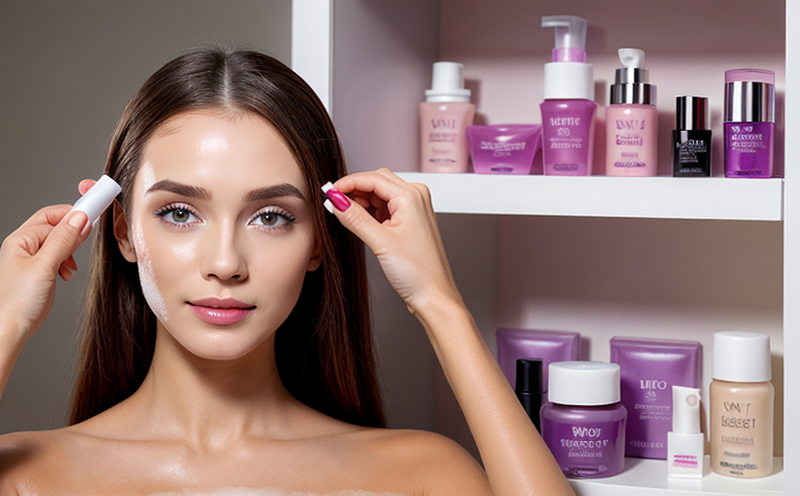Shelf Life Testing of Personal Care Products
The shelf life testing of personal care products is a critical component in ensuring product safety and efficacy. Shelf life refers to the period during which a product maintains its intended quality, effectiveness, and safety under specified conditions. For personal care products such as lotions, shampoos, conditioners, and makeup, it ensures that consumers receive high-quality products that do not pose any health risks.
The shelf life testing process involves several steps to assess the stability of a product over time. This includes evaluating physical properties (such as color, texture, viscosity), chemical properties (such as pH, active ingredient concentration), and biological properties (such as microbial content). These tests are conducted under controlled environmental conditions that simulate real-world storage scenarios.
One key aspect of shelf life testing is the determination of stability over time. This involves monitoring changes in product characteristics at regular intervals throughout its shelf life. The goal is to identify any degradation or loss of quality before it reaches consumers. By understanding these parameters, companies can make informed decisions about labeling and packaging recommendations.
Another important factor is identifying appropriate storage conditions for personal care products during their entire lifecycle. This includes temperature ranges, humidity levels, light exposure, and shelf life under various conditions. Proper storage helps extend the product's shelf life while maintaining its safety and effectiveness.
The results of this testing provide valuable insights into how long a particular formulation can remain stable before requiring replacement or disposal. These findings are essential for manufacturers who need to ensure that their products meet regulatory requirements and satisfy customer expectations regarding freshness and quality.
Why It Matters
Shelf life testing is crucial because it ensures the safety, efficacy, and performance of personal care products throughout their intended usage period. Without proper shelf life testing, there's a risk that consumers could be exposed to potentially harmful or ineffective products.
- Potential Hazards: Products with expired shelf lives may contain decomposed ingredients which can lead to irritation or allergic reactions when used on skin or hair.
- Efficacy Issues: Degraded active ingredients reduce the effectiveness of treatments like sunscreens, moisturizers, and anti-aging serums. This not only wastes resources but also fails to deliver expected benefits to consumers.
- Regulatory Compliance: Regulatory agencies worldwide enforce strict guidelines on cosmetic product safety and quality control which necessitate rigorous shelf life testing before market release.
In summary, accurate shelf life testing helps maintain consumer trust by delivering safe, effective products consistently. It also supports compliance with international standards such as ISO 28159:2016 for personal care products.
Scope and Methodology
| Parameter | Description |
|---|---|
| Physical Properties | Evaluation includes color change, texture variation, viscosity alteration, etc. |
| Chemical Properties | Focuses on pH levels, active ingredient concentrations, preservative efficacy, etc. |
| Biological Properties | Includes microbial load assessment and sterility checks where necessary. |
| Environmental Conditions | Testing under various temperature, humidity, and light exposure scenarios. |
The methodology involves setting up initial conditions for the products to be tested. This includes selecting appropriate containers, packaging materials, and storage environments that mimic commercial situations as closely as possible. Products are then stored according to these predefined conditions and monitored over time using both visual inspection and laboratory analysis.
During monitoring intervals, detailed records of all observed changes are kept. These observations help in determining the rate at which a product deteriorates under specific circumstances. Based on this data, optimal storage recommendations can be provided along with suggested replacement dates to ensure continued quality control.
Quality and Reliability Assurance
- Standard Operating Procedures: Adherence to established protocols ensures consistent results across all tests conducted within our facility.
- Digital Data Recording: Utilization of advanced software systems for accurate data capture and analysis enhances reliability.
- Inter-Laboratory Comparisons: Participating in benchmark exercises allows us to validate our methods against industry benchmarks.
- Continuous Improvement: Regular reviews and updates based on feedback from clients and advancements in technology ensure our processes remain state-of-the-art.
Our commitment to quality is reflected not only through robust internal practices but also through adherence to recognized international standards like ISO 28159:2016. By doing so, we provide assurance that every test conducted adheres to globally accepted criteria for accuracy and reliability.





